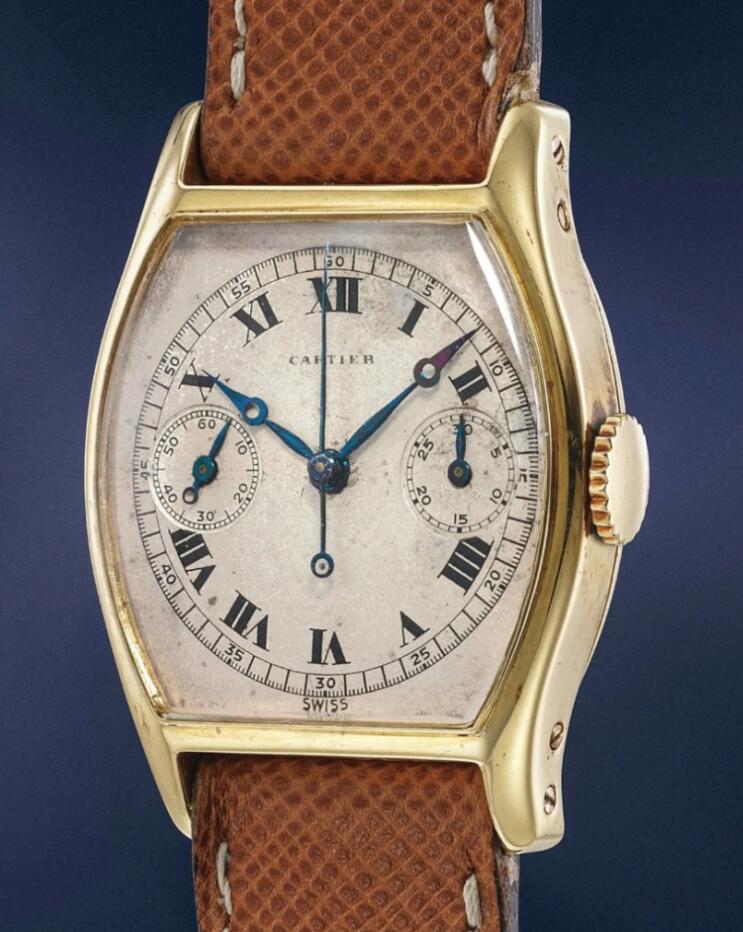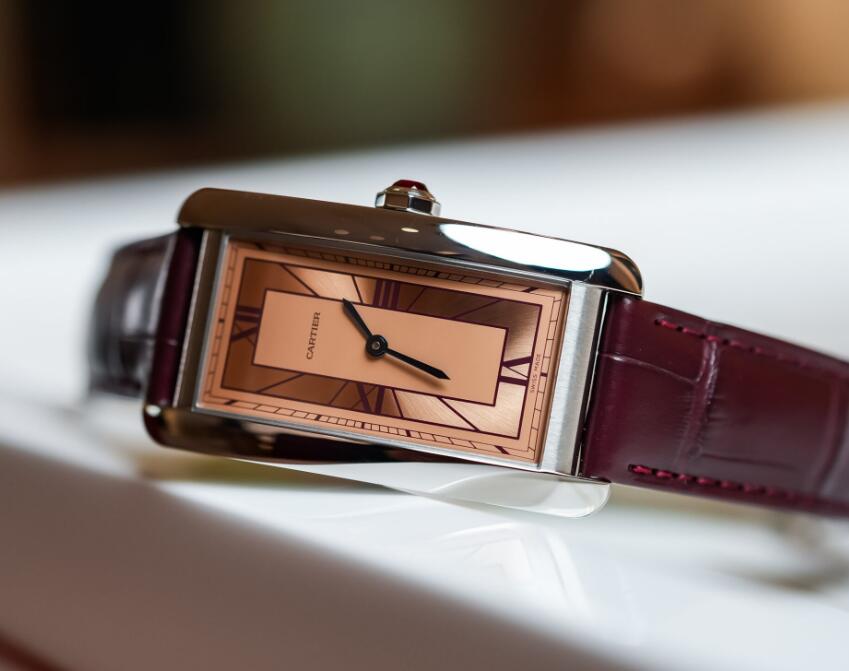Many new to the hobby of watch collecting are unfamiliar with Cartier’s history as a watchmaker and simply dismiss the maison out of hand as a jeweler. But this would be to miss out on a host of compelling models that have had an outsized impact on horology for well over a century. To wit: The Cartier Tortue, a lesser-known Swiss made Cartier super clone watches within the company’s portfolio that proves Cartier’s horological bona fides many times over.
By the time Louis Cartier designed the Tank in 1917 during the throes of the First World War, his maison had already released three other notable wristwatches: The Santos-Dumont in 1904, the Tonneau in 1906, and the Tortue in 1912. But while the Santos-Dumont and Tonneau are largely associated with the time-only simplicity more typical of Cartier’s elegant and streamlined designs, the Tortue (from tortue à pattes, or “tortoise on legs”) would quickly sprout proverbial legs and take on sophisticated complications: By 1928, the collection featured both monopusher chronograph and minute repeater complications, and in more recent decades, a host of other versions.
In the early years of producing wrist Cartier replica watches for sale, Cartier didn’t manufacture its own movements — indeed, many significant models from myriad brands were produced with calibers sourced from specialist movement makers such as Valjoux, Lemania, and others. Cartier, for its part, initially purchased movements from the leading watchmakers of the day; however, in the 1920s, it partnered with Edmund Jaeger (of what would become Jaeger-LeCoultre) to form the European Watch & Clock Company, a new business that supplied movements solely to Cartier. This forward-thinking and intrepid decision would furnish Cartier with a steady supply of movements both simple and highly complicated for serially produced as well as specialized timepieces.
The Tortue Monopoussoir

Long before the days of the now-common dual-button chronograph — one in which the top pusher starts and stops the chronograph, and the bottom pusher resets it — single-button (“monopusher”) models were the norm. Contrary to common wisdom, a monopusher is in fact easier to produce than a two-pusher chronograph (first pioneered by Breitling). In 1928, Cartier released the Tortue Monopoussoir, a positively diminutive timepiece that clocked in at just 25 mm wide by 35 mm lug-to-lug. Despite its small dimensions, however, it was an impressive piece of work both within and without: Its elegant, curved shape and smooth bezel did indeed resemble a tortoise as viewed from above, while the pusher in question was contained within the crown, making for a streamlined look with nothing to break its silhouette.
A silver dial with round chemin-de-fer outer minute track, UK 1:1 Cartier super clone watches‘ famous Roman numerals, and a blued steel Breguet handset were joined by two small registers: a 30-minute counter at 3 o’clock, and a running seconds indicator at 9 o’clock. Powered by a hand-wound European Watch & Clock Co. movement with a column wheel and horizontal clutch, this model was produced in an exceedingly small run of less than 15 pieces. (One hammered at Phillips in 2021 for CHF 189,000, or around $211,000 at conversion as of this writing.)
The Tortue Minute Repeater
It’s positively startling to think that Cartier was producing a minute-repeating wristwatch merely a decade after the conclusion of the First World War—the event that catalyzed the acceptance of the “wristlet” among men—but such is the business and design acumen of the Parisian maison. To this day, a minute-repeater, or chiming watch, is largely considered the most complicated to produce. Indeed in 1928, the same year it birthed the Monopoussoir, Cartier released a minute-repeating cheap fake Cartier Tortue watches capable of audibly chiming the time. Measuring 30mm x 33mm in yellow gold, its case was broken by a discrete slider on its left flank that triggered the repeater function, while its movement was built by European Watch & Clock Company. An example belonging to a New York City stockbroker sold at Antiquorum in 2002 for CHF 312,500, or around $349,000.
CPCP Era
By the 1974, the Cartier family had sold the business’s various branches in Paris, New York, and London. Production dramatically increased from just a few thousand pieces per year to multiple six-figures by the end of 1970s—a time that coincided with the onset of “the Quartz Crisis” as relatively inexpensive, highly precise quartz-powered offerings such as Must de Cartier came to market to fight with conterfeits. However, by the 1990s, the maison was preparing to reintroduce its heritage designs and refocus on mechanical horology, which it did by debuting the Collection Privée Cartier Paris (abbreviated “CPCP”) in 1998. Through collaboration with watchmakers both within and outside of the Richemont Group (Jaeger-LeCoultre, Piaget, Girard Perregaux, and others), Cartier offered both limited and non-limited (though low-production) runs of classic models, including the luxury super clone Cartier Tortue watches. However, it was collaborations with horological masters Jedi Renaud & Papi and Techniques Horlogères Appliquées (THA) that would yield some of the most stunning references.

Most notable is the CPCP take on the perfect copy Cartier Tortue Monopoussoir watches: Released in white, yellow, and pink gold, it was powered by the hand-wound 045 MC caliber developed by THA, a firm founded by none other than star watchmakers Denis Flageollet, Vianney Halter, and François-Paul Journe. Debuting in 1999 before A. Lange & Söhne’s Datograph ushered in a new era of in-house chronograph movement production, the new Monopoussoir, with its exclusive caliber, paved the way for a fresh focus on high-end movement development.

Other complicated CPCP Tortues were no less notable: The Perpetual Calendar, powered by the caliber 9421 MC, featured a Dubois Dépraz calendar module, a hand-guillochéd dial, and a four-subdial array. (Like all CPCP watches, its dial was signed “Cartier Paris” in a reference to the brand’s deepest watchmaking history.) The Tortue XL, meanwhile, featured an outsized date as well as an 8-day power reserve courtesy of Jaeger-LeCoultre, while the Tortue XL Day and Night boasted a delightful, oversized day/night indicator and the automatic caliber 9904 MC. If these weren’t enough to get one’s heart rate up, the Swiss made super clone Cartier Tortue XL Tourbillon Chronographe Monopoussoir and Tortue Minute Repeater watches were masterworks of haute horlogerie, their 9431 MC and movement 909 MC movements the products of Renaud & Papi. (Except for the yellow and pink gold minute repeaters, which used the caliber 9401 MC based upon an ébachue from Frederic Piguet.)
The In-Between Years
Following the discontinuation of the CPCP program in 2008, Cartier launched the Tortue Perpetual Calendar powered by the automatic caliber 9422 MC in 2010. Rather than release a dedicated 100th anniversary model in 2012, the maison instead released several Tortue models between 2012 and 2013: The Tortue XL with outsized date and sub-seconds, was powered by the automatic caliber 9602 MC, while the Tortue XXL Multiple Time Zones, an interesting take on the travel watch, used the automatic caliber 9914 MC. Several smaller ladies models followed in late 2013/early 2014.
Beginning with the Tortue XL, you’ll notice a few key differences between it and its CPCP ancestor: For one thing, the guilloché pattern on the dial appears slightly more prominent on the 2013 release; for another, the outsize date has been moved from an admittedly awkward 7 o’clock on the CPCP version to a more harmonious 12 o’clock. Sub-seconds are likewise relocated from 5 o’clock to 6 o’clock and given a guilloché treatment, and the power reserve indicator is absent entirely. Despite its lack of a chemin de fer minute track—arguably a Cartier signature, though it of course features on myriad other top UK Cartier replica watches from numerous brands—the 2013 Tortue XL is no doubt a more balanced design.

The best super clone Cartier Tortue Perpetual Calendar watches, launched in 2010, measured a hefty 41.2mm in diameter and featured a combination leap year and month indicator at 12 o’clock, a retrograde day indicator across the dial center, and a radial date indicator along the dial periphery. With blued steel Breguet hands, a chemin de fer minute track, black Arabic indices, and a cabochon-set crown, the Tortue Perpetual Calendar certainly identifies as a Cartier, but the partially skeletonized movement revealing the automatic caliber 9422 MC beneath gives it a more avant garde bent.

Finally, the Tortue XXL Multiple Time Zones rethinks the standard world timer display in a distinctly Parisian manner: Below a depiction of the globe in the dial center is an hour track with with daytime and nighttime hands for displaying home time, while a set of Breguet hands indicate local time conventionally. A cleverly designed system allows the user to select, via a pusher on the case flank, an available time zone and even differentiate between winter and summer in accordance with the local hemisphere. (A small display in the case makes this surprisingly easy.) Powered by the automatic 9914 MC movement with 283 components, this is a large, complicated Tortue in the spirit of the original 1920s-era iterations.
Cartier Privé
While Cartier discontinued the Collection Privée Cartier Paris in 2008 (somewhat quietly and perhaps unofficially), it reconstituted it beneath the “Privé” collection in 2017, within which the maison focuses on one historic model each year. Much to collectors’ delight, 2024 proved to be the year that Cartier focused on the Tortue, releasing several limited editions: A modern Monopoussoir produced in 200 numbered examples in platinum and yellow gold; a time-only, two-handed version also limited to 200 examples in platinum and yellow gold; and a platinum-cased, diamond-set version limited to 50 examples. Robb Report’s then editor-in-chief chose the brand new Tortue as his best-of for Watches & Wonders.

The modern Monopoussoir retains the rough case dimensions as its earlier CPCP cousin, clocking in at 34.8 mm wide and 10.2 mm thick. Opaline white dial, chemin de fer minute track, black Roman (yellow gold version) or rhodium-plated (platinum version) numeral indices, blued steel Breguet hands, guillochéd subdials, and a cabochon-set crown are all present and accounted for. This being a thoroughly modern execution, however, the column wheel-activated, hand-wound caliber 1928 MC is visible via a sapphire caseback. Geneva striping and other finishing techniques abound, and the entire movement is shaped to fit the high quality fake Cartier watches‘ unique shaped case.
The time-only Tortue, measuring 32.9 mm in diameter, likewise features a white opaline dial with chemin de fer minute track, black Roman (yellow gold version) or rhodium-plated (platinum version) numeral indices, Breguet hands, and a cabochon-set crown. They do not, however, feature any guilloché, and their minute track is situated at the dial periphery like on the 1928 minute repeater, rather than within the hour track as on the CPCP time-only watches. The Breguet hands, rather than being blued steel, match the case metal of each reference.
The Future of the Tortue

With its curvaceous case, elegant dial, and easy adaptability to house multiple complications and suit different metals, the Cartier Tortue super clone watches for sale is easily one of Cartier’s most compelling and versatile horological platforms. More than a century old, it’s a design that only now seems to be attracting the attention it so deserves, with auction prices heating up as younger collectors discover the wonders of CPCP-era pieces and the rarity of early 20th-century originals. With scholarship around the Tortue finally catching up to the levels that surround the Santos-Dumont, Baignoire, and certain iterations of the Tank, we can be sure to see continued interest in this fascinating collection—as well as, hopefully, more new iterations from Cartier itself.



